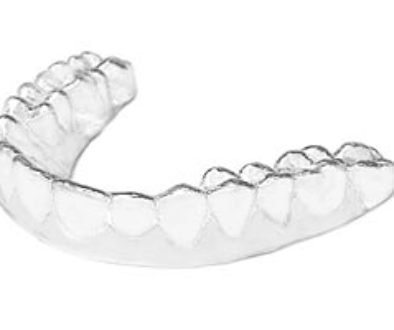How to Brush Your Teeth With Braces (And Other Tips and Tricks)

Keeping your teeth clean while you’re in braces is challenging, to say the least. Don’t worry though! It is possible to keep them clean and your teeth and gums healthy. I’m going to show you all the tips and tricks here.
How To Brush Your Teeth While In Braces
A lot of people brush their teeth by smearing a bit of toothpaste on their toothbrush and rubbing it around haphazardly for the next 30 seconds. This may be just enough for some people but it definitely won’t cut it while you’re in braces. You need good technique and to spend enough time doing it.
With a regular soft toothbrush you’ll need to modify your technique a bit to clean those braces well. You want to angle your toothbrush at a 45 degree angle to the teeth from both the top and bottom side of the brackets. Vibrate the toothbrush quickly back and forth (small strokes, not big) and continue this all the way around. You’ll want to spend a minimum to 2 minutes twice a day doing this to get a good solid clean.
If you’re able to, I’d highly recommend you invest in a good solid electric toothbrush. They make several different head types for electric toothbrushes and some of them are specially made for braces. They’ll allow you to get in between those teeth and brackets without too much effort. My personal favorite electric toothbrush is the Oral B Professional Series.
Brushing well with braces is good but you also have to find some way to clean in between those teeth…
How to Floss Your Teeth While in Braces
When I was in braces I remember the orthodontist handing me a pack of floss threaders and saying that I’d need to thread the floss around each and every tooth. Guess what I did? I threw the floss threaders out and didn’t give it a second thought. What teenager wants to spend 15 minutes a night flossing?
You’ve got to make the right thing the easy thing to do. I’m going to show you how to do that.
Fortunately we’ve got a lot more options these days for keeping your teeth clean while you’re in braces. In addition to brushing your teeth, this is going to be one of the most important things you can do to keep your teeth and gums healthy while you’re in braces. More on those dangers in a second.
So you can use those floss threaders and go around each and every tooth with the floss, but I wouldn’t recommend it. A FAR better option is to buy a Waterpik. A Waterpik uses a jet of water under pressure to clean around and in between your teeth. Studies have shown that it is even more effective than regular string floss at cleaning between your teeth. It is also a lot easier to use than floss threaders and works faster. That’s a win-win for you. It can be a bit messy with the jet of water shooting around your bathroom if you’re not careful.
Another option is to use interproximal brushes such as a proxabrush. Unless you’ve got really big spaces between your teeth, you’ll want to get the smallest version of these so that you can get them in between your teeth. These look like small, expensive pipe cleaners. You basically take them and gently push them between your teeth to clean all those areas your toothbrush couldn’t get. They are disposable so you’ll end up buying and throwing a lot of these away while you’re in braces. I like these mostly for when you’re on the go and don’t have access to your Waterpik.
The Dangerous Road of Not Brushing Braces
I can remember off the top of my head more than a couple of people who’ve come out of braces with white spots all over their teeth. Yep, they’ve got nice straight teeth with white spots all over them.
These white spots are known as “decalcification”. All that plaque left on their teeth allowed the bacteria to get out of control and start breaking down the enamel. The first sign of this is white spots.
Sometimes these white spots will turn brown over time and become quite an eyesore. There are some treatments to help minimize these white spots but they usually don’t go away entirely.
Another danger of not brushing is that your gum tissue can become very irritated. This will cause your gums to bleed easily and get large and puffy. I’ve seen some kids in braces whose gum tissue grew right over the orthodontic brackets. It’s not an easy fix when it gets to that point. Prevention is far better.If left to go for too long you can even start losing bone around your teeth. That’s definitely not something you want to start while you’re in braces.
If your orthodontist sees any of these things happening while you’re in treatment, they may even take the nuclear option! Occasionally they’ll take your braces all the way off before their finished and send you over to your regular dentist to get your gums and teeth healthy again. As you can imagine this isn’t a whole lot of fun and adds a ton of extra time to your treatment.
Watch That Diet
This applies to everyone, but it is especially important while you are in braces. You’ll want to avoid consistent snacking on sugary foods, carbohydrates such as chips or crackers, and drinking sugary or acidic drinks (that includes diet sodas!).
Remember those “decalcified” white spots we talked about earlier? If you eat or drink enough sugar, carbs, and acidic things these will develop no matter well how you brush and floss.
See Your General Dentist Regularly
Make sure you keep up with those 6 month check-up and cleaning appointments with your general dentist. Dentists have tools that allow them to thoroughly clean all around your braces, especially those hard to get to spots where tartar buildup has occurred. They’ll also be able to catch any early signs of decalcification or gingivitis and help you correct it before it is a big issue. Sometimes they’ll do additional fluoride treatments as a preventative measure against decalcification.
If you’re really worried about decay forming or if you know that you develop cavities faster than other people ask your dentist to prescribe a prescription strength fluoride toothpaste such as Prevident 5000. This has 5000 parts per million of fluoride in it compared to about 1000-1500 that you get in regular toothpaste.



